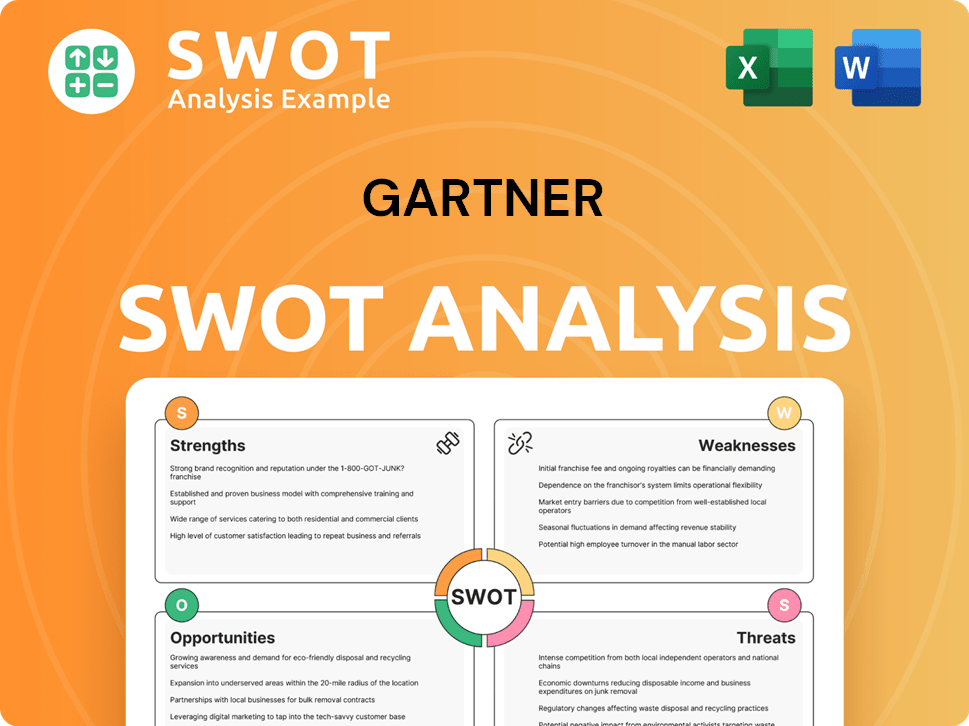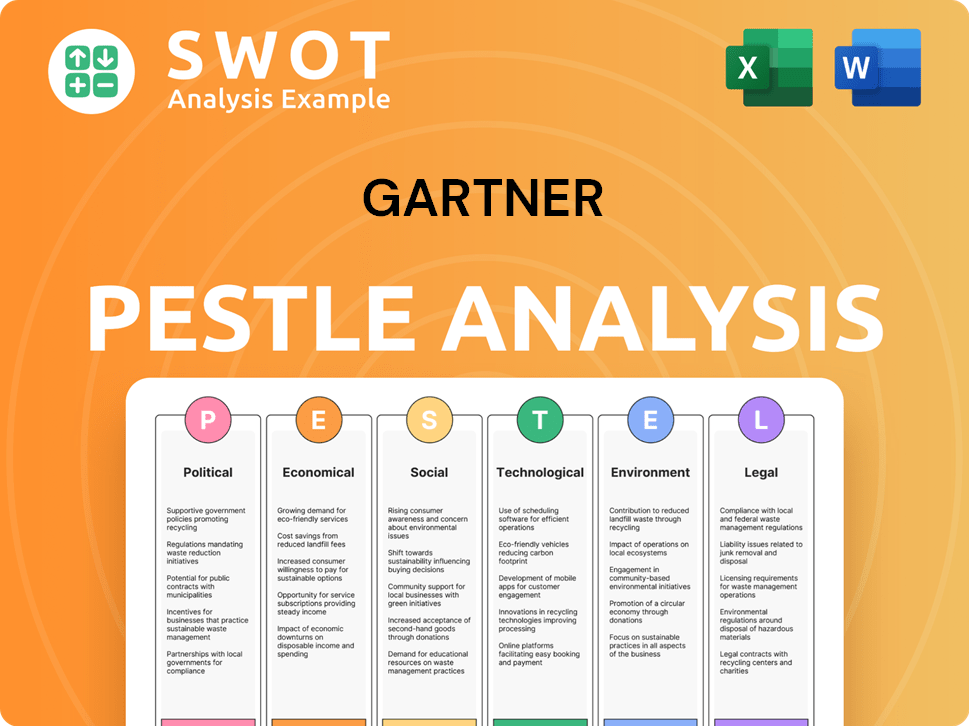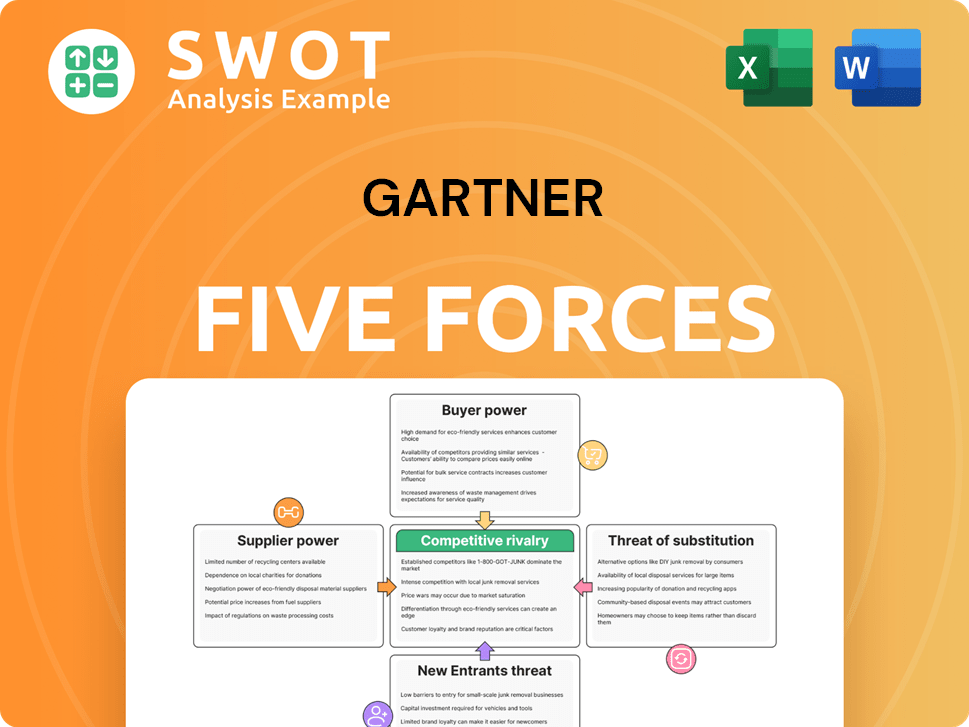Gartner Bundle
Who Does Gartner Serve?
In today's fast-paced business world, understanding your customer is paramount. For a company like Gartner, a deep dive into its customer demographics and target market is essential for strategic success. Founded in 1979, Gartner has evolved from an IT research provider to a comprehensive advisory partner. This evolution demands a close examination of its current client profile and future growth strategies.

This analysis explores the core of Gartner's business: its customers. We'll uncover the "who," "where," and "why" behind Gartner's client base, examining their needs and how Gartner strategically caters to them. Understanding the Gartner SWOT Analysis helps to understand the company's position. This exploration will provide valuable insights into Gartner's market research, target audience, and industry analysis, revealing how it maintains its competitive edge in a dynamic global market. We'll also explore Gartner's customer geographic locations and how it defines its target market.
Who Are Gartner’s Main Customers?
Understanding the customer demographics of Gartner is crucial for grasping its market position and strategic focus. The company primarily serves a business-to-business (B2B) market, providing insights and advisory services to a wide array of industries. The Gartner target market is composed of leaders and decision-makers within large organizations, who rely on Gartner's research and consulting to make informed choices.
Gartner's client profile is characterized by its emphasis on executive leadership across various functions. This includes Chief Information Officers (CIOs), Chief Marketing Officers (CMOs), and other senior executives. These leaders use Gartner's offerings to address critical priorities and improve performance. This focus allows the company to provide targeted solutions and maintain a strong presence in the enterprise market.
The company's customer base is segmented into two main groups: Global Technology Sales (GTS) and Global Business Sales (GBS). These segments reflect Gartner's strategic approach to serving its diverse client base. The structure helps the company tailor its services and maintain a strong presence in the enterprise market. If you want to know more about the business model, check out the Revenue Streams & Business Model of Gartner article.
GTS focuses on IT departments, representing the largest segment of Gartner's business. In 2024, GTS accounted for over 75% of Gartner's total contract value. The GTS contract value reached $4.0 billion by the end of 2024, showing a 7% increase from the previous year.
GBS serves functions beyond IT, including HR, Supply Chain, Marketing, and Finance. GBS represents almost 25% of the total contract value. GBS experienced a 12% year-over-year increase, reaching $1.2 billion by the end of 2024, indicating significant growth.
Gartner's customer demographics are further defined by the industries they serve. The company's market research and industry analysis help it to understand the evolving needs of its clients. This understanding allows Gartner to provide relevant and valuable services.
- The fastest growth within the Research segment in 2024 was observed in manufacturing, healthcare, and the public sector.
- These sectors highlight areas of increasing demand for Gartner's services.
- Gartner's ability to adapt to industry-specific needs is a key factor in its success.
- Understanding these key customer segments is critical for Gartner's strategic planning and market positioning.
Gartner SWOT Analysis
- Complete SWOT Breakdown
- Fully Customizable
- Editable in Excel & Word
- Professional Formatting
- Investor-Ready Format

What Do Gartner’s Customers Want?
Gartner's customers, encompassing a diverse range of organizations, are united by their need for actionable insights to navigate complex business environments. This includes understanding market trends, optimizing technology investments, and addressing evolving challenges. The core of Gartner's value proposition lies in providing objective, data-driven guidance to inform critical business decisions.
The primary driver for Gartner's clients is the need to make informed decisions about their mission-critical priorities. This involves a deep dive into market research, technology evaluations, and strategic planning. Clients leverage Gartner's research and analysis to stay ahead of the curve, optimize spending, and mitigate risks in their respective industries.
Customers seek guidance on emerging technologies, particularly generative AI, which is driving significant investment. Gartner's insights help clients understand the potential of these technologies and develop realistic implementation strategies. The company tailors its offerings through its Insights Platform, direct engagement between analysts and clients, industry-leading conferences, and consulting services.
CIOs are increasing their budgets, but a significant portion is expected to offset price increases in recurrent spending. Gartner's insights help CIOs prioritize and optimize their IT spending, which is forecasted to reach $5.61 trillion in 2025 globally, a 9.8% increase from 2024.
Customers need guidance on emerging technologies, particularly generative AI, which is driving significant investment in new infrastructure. Gartner forecasts AI hardware investment to surge, with spending on AI-optimized servers reaching $202 billion in 2025.
CMOs are prioritizing investments that improve the customer journey, recognizing that over half of consumers don't feel understood by brands. They are also grappling with balancing short-term operational demands with long-term strategic planning.
Gartner addresses these pain points by emphasizing the importance of developing robust strategy management capabilities. Gartner's offerings help clients focus on identifying and fulfilling unmet customer needs to achieve market differentiation.
Gartner's research and consulting services are designed to address key customer pain points, such as optimizing IT spending, understanding AI's potential, and improving customer engagement. The company's offerings are tailored to meet the specific needs of different customer segments.
Gartner tailors its offerings through its Insights Platform, direct engagement between analysts and clients, industry-leading conferences, and consulting services for extended, project-based support. This ensures that clients receive the most relevant and actionable insights.
Gartner's approach is centered around understanding and addressing the evolving needs of its diverse client base. This involves providing comprehensive market research, strategic guidance, and practical implementation strategies. The company supports its clients through various channels, ensuring they receive the insights and support necessary to succeed.
- Insights Platform: Provides access to a vast library of research reports, data, and analysis.
- Direct Engagement: Clients can interact directly with Gartner analysts to discuss specific challenges and receive tailored advice.
- Industry-Leading Conferences: These events offer opportunities for networking, learning, and gaining insights from industry experts.
- Consulting Services: Gartner offers project-based support to help clients implement strategies and achieve their goals.
Gartner PESTLE Analysis
- Covers All 6 PESTLE Categories
- No Research Needed – Save Hours of Work
- Built by Experts, Trusted by Consultants
- Instant Download, Ready to Use
- 100% Editable, Fully Customizable

Where does Gartner operate?
The geographical market presence of the company is extensive, with operations spanning approximately 90 countries. This broad reach helps to mitigate geopolitical risks and provides a diverse customer base. The company's global footprint is a key factor in its ability to serve a wide range of clients and maintain a strong market position.
In fiscal year 2024, the United States and Canada were the largest contributors to the company's revenue, generating $4.02 billion. This represents a 2.73% increase compared to the previous year. The EMEA region also demonstrated significant growth, with revenues reaching $1.52 billion, reflecting a robust 13.94% increase.
Other international markets contributed $731.9 million in revenue, showing a 10.25% growth in 2024. This demonstrates the company's ability to expand its presence and capitalize on opportunities in various regions. The company's strategic approach to market localization and customer engagement is crucial for its success in diverse global markets.
The United States and Canada are the primary revenue drivers for the company, highlighting the importance of the North American market. This region's robust technology spending and business environment contribute significantly to the company's overall financial performance. Understanding the customer demographics Gartner serves in this area is critical for strategic planning.
The EMEA region is a significant growth area, with a substantial increase in revenue in 2024. This growth is driven by increased IT spending and the adoption of new technologies. The company's ability to adapt to regional market dynamics is key to its success in EMEA. The Gartner target market is expanding in this region.
Other international markets are also experiencing growth, demonstrating the company's global reach and ability to penetrate new markets. This expansion is supported by tailored strategies that address the unique needs of each region. The company's international presence is a key factor in its ability to provide comprehensive Gartner market research.
The company adapts its offerings and engagement strategies to cater to specific market dynamics and customer preferences within different regions. For example, the shift towards buying generative AI solutions in Europe in 2025 indicates a regional adaptation in how organizations are approaching new technologies. This adaptation is essential for meeting the Gartner audience's specific needs.
In Europe, IT spending is projected to reach $1.28 trillion in 2025, marking an 8.7% increase from 2024. This growth is fueled by investments in AI-related infrastructure and public cloud spending, indicating significant opportunities for the company. To learn more about the company's strategic growth, consider reading about the Growth Strategy of Gartner.
Gartner Business Model Canvas
- Complete 9-Block Business Model Canvas
- Effortlessly Communicate Your Business Strategy
- Investor-Ready BMC Format
- 100% Editable and Customizable
- Clear and Structured Layout

How Does Gartner Win & Keep Customers?
Gartner's customer acquisition and retention strategies are integral to its business model, which is primarily subscription-based. This model inherently supports client retention due to the ongoing nature of the services provided. The company focuses on delivering high-value, objective insights to its clients, fostering long-term relationships and recurring revenue streams. This approach is critical for the company's financial health, as seen in its total revenues of $6.3 billion in 2024.
For acquiring new customers, Gartner leverages its strong brand presence and thought leadership within the market research and industry analysis sectors. The company uses its conferences and consulting services to showcase its expertise and engage with potential clients. The Consulting segment, which saw a 9% growth in 2024, plays a crucial role in attracting new business through project-based services.
Retention is a key priority for Gartner, with strategies emphasizing client engagement and personalized advisory services. They also focus on providing exceptional value, which is reflected in its strong financial performance. Furthermore, Gartner's commitment to returning capital to shareholders through share repurchase programs also signals financial health and long-term stability, which can indirectly contribute to client confidence and retention.
Gartner utilizes its thought leadership and market presence to attract new clients. The Conferences segment serves as a key channel for showcasing expertise and engaging with potential clients. The company also focuses on expanding its sales force and leveraging AI internally for targeted outreach.
Retention strategies emphasize client engagement and personalized advisory services. In Q4 2024, contract values with technology and business function leaders increased, highlighting successful client engagement. Providing exceptional value, reflected in strong financial performance, is also key.
Gartner's conferences are a significant acquisition channel, with revenues increasing to $583.2 million in 2024. These events provide a platform to showcase expertise and engage with potential clients. They are a crucial part of Gartner's strategy to reach its target audience.
The Consulting segment, which grew by 9% in 2024, plays a role in attracting new business through project-based services. This segment allows Gartner to offer tailored solutions, attracting clients who need specific, in-depth guidance. This approach helps to expand the client base.
Gartner's approach to customer acquisition and retention is multi-faceted, focusing on delivering value through research, conferences, and consulting services. The company's success in these areas is evident in its financial performance and high client retention rates. As the Competitors Landscape of Gartner demonstrates, understanding these strategies is critical for appreciating Gartner's market position.
Gartner Porter's Five Forces Analysis
- Covers All 5 Competitive Forces in Detail
- Structured for Consultants, Students, and Founders
- 100% Editable in Microsoft Word & Excel
- Instant Digital Download – Use Immediately
- Compatible with Mac & PC – Fully Unlocked

Related Blogs
- What are Mission Vision & Core Values of Gartner Company?
- What is Competitive Landscape of Gartner Company?
- What is Growth Strategy and Future Prospects of Gartner Company?
- How Does Gartner Company Work?
- What is Sales and Marketing Strategy of Gartner Company?
- What is Brief History of Gartner Company?
- Who Owns Gartner Company?
Disclaimer
All information, articles, and product details provided on this website are for general informational and educational purposes only. We do not claim any ownership over, nor do we intend to infringe upon, any trademarks, copyrights, logos, brand names, or other intellectual property mentioned or depicted on this site. Such intellectual property remains the property of its respective owners, and any references here are made solely for identification or informational purposes, without implying any affiliation, endorsement, or partnership.
We make no representations or warranties, express or implied, regarding the accuracy, completeness, or suitability of any content or products presented. Nothing on this website should be construed as legal, tax, investment, financial, medical, or other professional advice. In addition, no part of this site—including articles or product references—constitutes a solicitation, recommendation, endorsement, advertisement, or offer to buy or sell any securities, franchises, or other financial instruments, particularly in jurisdictions where such activity would be unlawful.
All content is of a general nature and may not address the specific circumstances of any individual or entity. It is not a substitute for professional advice or services. Any actions you take based on the information provided here are strictly at your own risk. You accept full responsibility for any decisions or outcomes arising from your use of this website and agree to release us from any liability in connection with your use of, or reliance upon, the content or products found herein.